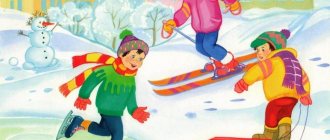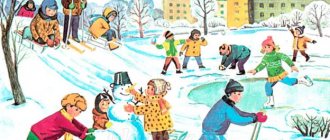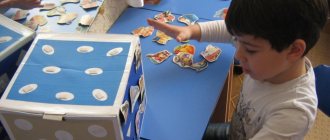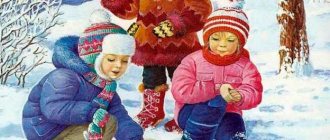Card file of autumn walks (senior group)
November.Card No. 5
1.Observation of rowan
Target:
consolidate knowledge about the benefits rowan brings to animals and birds in the cold season.
Progress of observation
So the first frost caught the rowan berries, they became tasty and soft. Animals and birds love rowan. A bear, if he finds it in the forest, hung with bunches of berries, will deftly tilt the flexible tree and enjoy its fruits with pleasure; The forest giants, elk, also like rowan berries. They reach the very top of the tree and eat fruits and branches with appetite. Berries that fall to the ground are picked up by voles, hedgehogs, chipmunks and squirrels. On pre-winter November days, flocks of bullfinches and waxwings arrive. They stick around the rowan and peck its juicy sweet berries. The birds peck quickly, dropping a lot of berries on the ground, then fly away further. Rowan saves many birds from hunger.
The crane's cry has already sounded, The garden has long since crumbled, And the bright clusters of rowan berries are still burning, hanging down.
2. “Sand cone” experiment.
Target:
show the property of sand - flowability.
Material: sand.
Procedure: Take a handful of dry sand and release it in a stream so that it falls in one place.
Gradually, a cone forms at the site of the fall, growing in height and occupying an increasingly larger area at the base. If you pour sand for a long time, first in one place, then in another, drifts occur; the movement of sand is similar to a current.
Conclusion: the property of sand is flowability.
3. Outdoor games
"Planes", "Sparrows and the Cat".
Target:
teach to quickly perform movements at the teacher’s signal and run in the indicated direction; cultivate friendliness.
4.Individual work
"Get in the basket."
Target:
develop accuracy and eye.
5. Didactic game
"Hide and Seek"
Target:
learn to find a tree by description, consolidate the ability to use prepositions in speech: behind, about, before, next to, because of, between, on; develop auditory attention.
6.Independent motor activity
November.
Card No. 5. Evening walk
1. Observation of migratory birds
Target:
expand ideas about migratory birds, about the changes in the life of birds in the fall, when cold weather sets in; foster love and care for birds.
The waters rustled like a fast stream, Birds flew away to warmer lands.
The teacher asks the children questions: What birds fly to warmer climes? Why are they doing that?
Birds gather in flocks and fly low above the ground. This means that they will soon fly away to warmer climes. Swallows will be the first to do this, since with the onset of cold weather the insects they catch in flight disappear. The last to fly away are ducks, geese, and cranes, as water bodies begin to freeze and they cannot find food in the water.
The teacher invites the children to complete the sentence:
• The sparrow is small, and the crane... (big).
• The duck is gray, and the swan... (white).
2. Didactic game “What kind of bird is this?”
Target:
clarify and expand ideas about bird life in autumn; describe birds by their characteristic features; cultivate a caring attitude towards birds.
Progress of the game:
Children are divided into 2 subgroups. Children of one subgroup describe the bird, and the other have to guess what kind of bird it is. You can use riddles. Then another subgroup asks their questions.
3. Word game “Do you remember these poems?”
Goal
: development of memory, attention, speech activity.
Progress of the game:
the teacher reads excerpts from poems familiar to the children. Children must pronounce the missing words.
Where did the sparrow have lunch? Don't stand too close:
At the zoo there are... (animals). I (tiger cub)
but not (…).
Wind across the sea (...)
And (...) customizes. Etc.
4. Outdoor game “Sparrows”. Target:
activation of the sound [h] in onomatopoeia;
development of dexterity. Progress of the game:
Children (sparrows) sit on a bench (in nests) and sleep. In response to the teacher’s words: “Sparrows live in a nest and everyone gets up early in the morning,” the children open their eyes and say loudly: “Tweet-chik-chik, chirp-chik-chik! They sing so joyfully."
After these words, the children scatter around the area. To the words of the teacher: “They flew to the nest!” - return to their places.
Labor activity:
Collecting pebbles on the site.
Target:
develop the ability to notice cleanliness in the area.
Progress of observation.
What time of year is it now? How did you guess that it was autumn? List the characteristic signs of autumn?
Why did it get cold in autumn? What does a person do in the fall? How do different animals adapt to life in the cold season?
The sun does not shine so brightly in autumn, and it often rains. There are frosts in the morning. Birds gather in flocks and fly south.
Labor activity.
Cleaning the kindergarten area from fallen leaves - teach yourself and other children to create a joyful mood from the work done.
Outdoor game.
"Stop"
— develop children’s motor activity.
Individual work.
Jumping forward.
Drawing with crayons. Independent activity of children with external materials.
Walk 2
Sparrow watching
Objectives: to deepen knowledge about the features of a sparrow’s appearance and life manifestations; activate children's attention and memory.
Progress of observation
Guys, look, one leaf flies to the ground, then the other spins, spins and slowly falls to the ground. The wind blew and many, many rustling leaves flew to the ground. This is LEAF FALL. Leaves fly slowly because they are light. Let's go wander through the leaves. Do you hear how they rustle?
Collection of autumn leaves.
Labor activity.
Cleaning the kindergarten area from fallen leaves.
Outdoor game
"Find where it's hidden"
- learn to navigate in space.
Individual work
Walking on a narrow path - improve your walking technique while maintaining balance.
Drawing "Leaf fall"
- invite children to collect beautiful leaves that have fallen from various trees, outline them with chalk, and color the picture.
Independent activity of children with external materials.
Walk 10
Monitoring the work of the janitor
Objectives: expand knowledge about adult labor in the fall; cultivate respect for work.
Progress of observation
What vegetables grow in our garden? What kind of work did you do together with the teachers in the garden?
What do adults do in the garden in the fall?
Riddles about vegetables.
Labor activity
Help with cleaning in the greenhouse - cultivate a desire to help adults.
Outdoor game
"Pass the ball to your partner"
— learn to throw with both hands from the chest.
Individual work
"Jump over the puddle"
— teach standing long jump.
Games at the request of children with external materials.
Walk 9
Watching leaf fall
Objectives: consolidate knowledge of the signs of late autumn; clarify why the fall of leaves is called leaf fall.
Progress of observation
The plants in the flowerbed grew well, bloomed while it was warm, there was a lot of light and water; now the days are becoming short, there is a lot of water, but little heat, the flowers are fading, and in their place seeds are formed, from which new plants can appear.
What did the flowers in the flowerbed look like? Why did they wilt? What needs to be done to make the flowers grow again in the spring? (Collect seeds.)
Labor activity.
Collecting seeds in a flower garden - to develop labor skills.
Outdoor game
"Chasing the Ball"
- develop running, attention and agility.
Individual work
"Jump further"
- learn to run long jump.
Games at the request of children with external materials.
Walk 8
Observing the work of an adult in a greenhouse.
Objectives: to intensify cognitive activity, maintain a strong interest in observations; encourage to take an active part in helping adults.
Progress of observation.
Walk around the area, examine and name what trees and shrubs ; detect signs of the beginning of autumn on them, admire the colorful leaves, examine the cover of the earth and note that the grass is still green, in some places there are fallen leaves on the grass, they are bright in color (yellow, red)
Labor activity.
Cleaning the kindergarten area from fallen leaves.
Outdoor game
"Fishing rod"
- consolidate jumps on two legs up.
Individual work.
Development of movements - strengthen the skills of throwing objects at a distance.
Games at the request of children with external materials.
Walk 4
Spider watching
Objectives: expand and consolidate knowledge about the characteristic features of the appearance of a spider, its life manifestations; form realistic ideas about nature.
Progress of observation.
Autumn rains are not at all like summer rains. Autumn rain is drizzling. As soon as small droplets begin to fall to the ground, it will continue to do so for a day, two, three. Often without stopping. And then it becomes very boring. There is slush underfoot, the sky is leaden, and cold, tedious rain is drizzling. It's good that autumn will eventually pass and winter will come. People wear raincoats and boots in the rain. Even the birds hid, they don’t want to get their feathers wet.
When does it rain drizzling, lingering? What mood does it evoke? How does nature react to rain? What are puddles? What do the clouds and sky look like?
Labor activity
Cleaning toys - develop in children a desire to help adults in putting things in order.
Outdoor game
"The deer has a big house"
— consolidate the ability to correlate movements with text.
Individual work
Development of movements - strengthen the ability to tap the ball on the floor with both hands.
Games at the request of children with external materials.
Walk 6
Weather observation
Objectives: to develop in children the ability to independently identify the first signs of autumn phenomena in nature, to establish relationships between changes in living and inanimate nature.
Progress of observation
What kind of cars are driving along our street? What or who are they transporting: people or cargo? (Of people.)
What is this car called?
(Passenger car.)
What parts does a passenger car have? (Cabin, wheels, doors, windows, steering wheel, headlights, etc.)
And who is leading it? (Driver)
Labor activity
Putting things in order in the sandbox helps to develop children’s work skills.
Outdoor game
"We are drivers"
- learn to listen carefully to the teacher’s commands.
Individual work
Walking on a gymnastic beam and jumping on both feet helps develop a sense of balance and the ability to jump from a height.
Games at the request of children with external materials.
Walk 12
Watching the grass
Tasks; give an idea of herbaceous plants (herbaceous plants have roots, stems, leaves)
; In autumn the grass changes its color, it turns yellow and dries.
Progress of observation
What does a sparrow look like? What does he eat?
How does he move? How does he sing?
The sparrow is a small, lively bird. The sparrow's back is brown, with wide longitudinal black stripes. The tail and wings are dark brown, decorated with a reddish border, the chin and throat are black, but the head is gray. The sparrow is an agile bird that picks up crumbs, seeds, and grains. He adapts well everywhere. Sparrows sing "chick-chirp"
.
Labor activity
Tidy up the sandbox.
Outdoor game
"Catch the Ball"
- strengthen the skills of throwing and catching the ball with both hands; cultivate attention and dexterity.
Individual work
"On a smooth path"
— teach children to walk in a column, one at a time, along a narrow path.
Optional games with external material.
Walk 3
Tree watching
Tasks: remind about the trees growing on the site; teach to distinguish them by the appearance of the trunk, crown, leaves; clarify the signs of autumn, its signs; develop logical thinking
Progress of observation
What is the weather today? What can you say about her?
What sky? What's on it?
Look around, is there any wind? How did you discover it?
Today is colder or warmer than yesterday, the day before yesterday (another day of the week?
What are we wearing?
How can you tell about the weather today? (cloudy, quiet, cool)
.
Labor activity
Cleaning the territory - teach to work together, achieve the task
Outdoor game
"Catch up with your mate"
- perform movements at the teacher’s signal; clearly navigate when finding your match.
Individual work
Development of movements - strengthen the skills of throwing objects at a distance.
Drawing with crayons “Our kindergarten”
— invite children to draw what they love about kindergarten.
Games at the request of children with external materials.
Walk 7
Observing the flower garden
Objectives: to develop children’s ideas that flowers are alive, they grow and change; introduce children to the name of autumn flowers and their structure.





